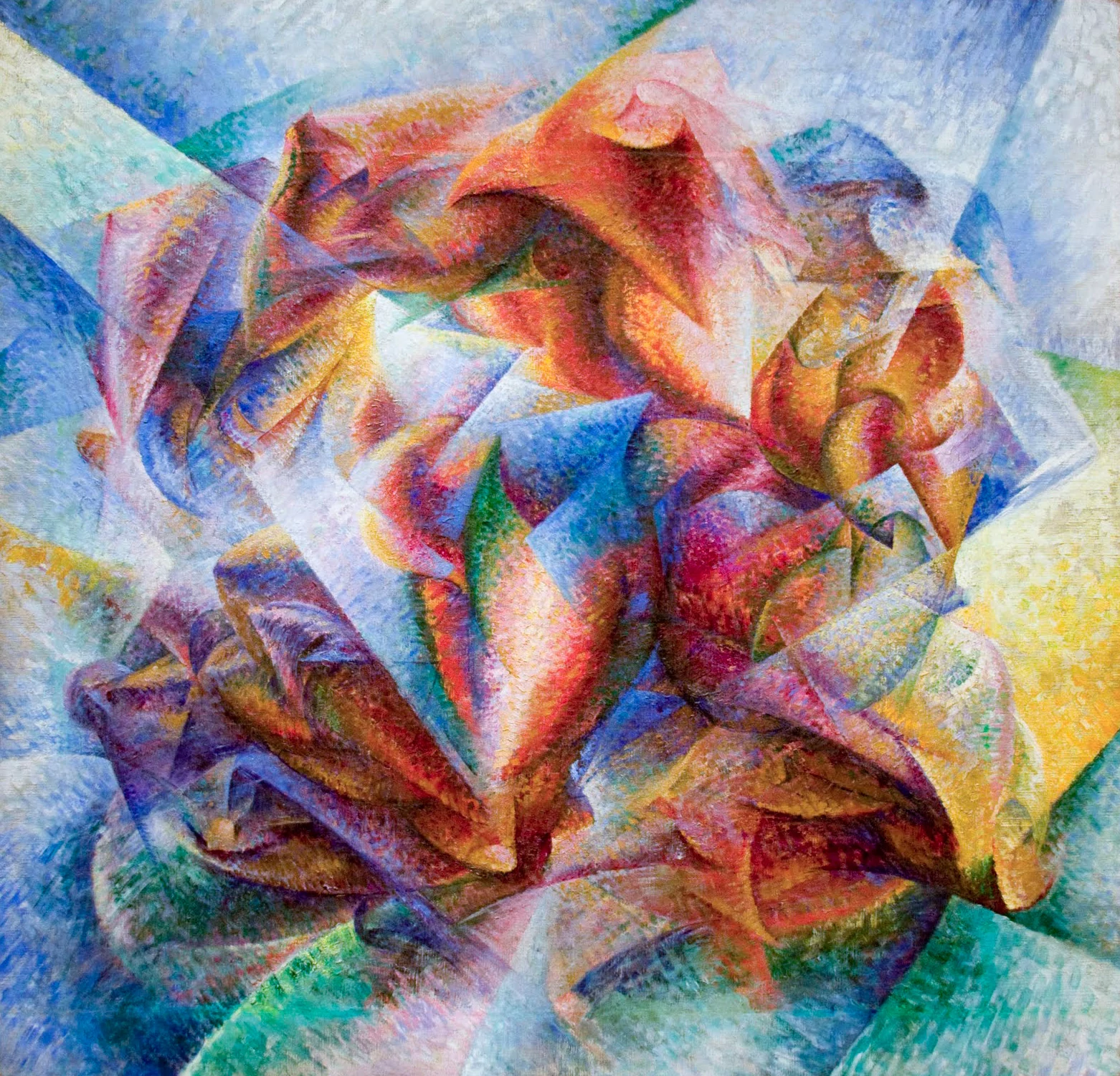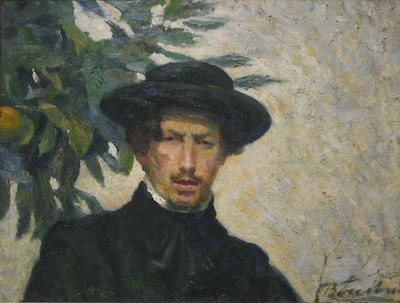

Umberto Boccioni
Why can’t I stop painting my mother?
1882 – 1916Plastic dynamism is the simultaneous action of the motion characteristic of an object (its absolute motion), mixed with the transformation which the object undergoes in relation to its mobile and immobile environment (its relative motion). Therefore, it is not true that only the decomposition of an object’s shape constitutes dynamism. Certainly decomposition and distortion in themselves have dynamic value, in so far as they break up the continuity of a line, interrupting the rhythm of a silhouette, increasing interactions and indicating possible directions of a shape. But this is not the Futurist concept of plastic dynamism, any more than a trajectory, the sway in a pendulum, or movement from point A to point B.
Dynamism is the lyrical conception of forms, interpreted in the infinite manifestations of the relativity between absolute motion and relative motion, between the environment and the object which come together to form the appearance of a whole: environment + object.
It is the creation of a new form which expresses the relativity between weight and expansion, between rotation and revolution; here, in fact, we have life itself caught in a form which life has created in its infinite succession of events.
It seems clear to me that this succession is not to be found in the repetition of legs, arms and faces, as many people have idiotically believed, but is achieved through the intuitive search for the one single form which produces continuity in space. This is the key to making an object live in universal terms. Therefore, instead of the old-fashioned concept of a sharp differentiation of bodies, instead of the modem concept of the Impressionists with their subdivision and repetition and rough indications of images, we would substitute a concept of dynamic continuity as the only form. And it is not by accident that I say ‘form’ instead of ‘line’ since dynamic form is a species of fourth dimension, both in painting and sculpture, which cannot exist perfectly without the complete concurrence of those three dimensions which determine volume: height, width, depth.
For sculpture we have tried to break the unity of material into several materials, each one of which serves to characterise, through its own natural diversity, differences in the weight and expansion of molecular volumes, and which together create the initial dynamic element.
Attempts to find realist form have always led sculpture and painting further and further away from their origin: architecture. Architecture represents for sculpture what composition does for painting; in fact, the absence of architectural elements is one of the negative characteristics of Impressionist sculpture.
However, pre-Impressionist studies of form have inevitably resulted in dead forms and, as a consequence, immobility; and this immobility is one of the main characteristics of Cubist sculpture.
Between real and ideal forms, between new forms (Impressionist) and traditional forms (Greek) we have discovered a form which is variable, evolutionary, and quite different from any other concepts which have existed up till now. We Futurists have discovered form in movement, and the movement of form. Only through this dual conception of form can we give a hint of plastic life in our work, without having extracted and removed it from its living environment, which would mean arresting its motion.
A body in movement, therefore, is not simply an immobile body subsequently set in motion, but a truly mobile object, which is a reality quite new and original.
In sculpture, therefore, we are not necessarily looking for pure form, but for pure plastic rhythm, not the construction of an object, but the construction of an object’s action. We have abolished pyramidal architecture to arrive at spiral architecture. A body in movement, therefore, is not simply an immobile body subsequently set in motion, but a truly mobile object, which is a reality quite new and original.
With dynamism, then, art climbs toan ideal, superior plane, creating a style and expressing our own age of speed and of simultaneity. When people tell us that the world has examples of both static and moving objects, and that not everything rushes around at speed, we reply that, in our painting it is the conception which dominates the visual, which perceives only fragmentarily, and therefore subdivides. Hence Dynamism is a general law of simultaneity and interpenetration dominating everything, in movement, that is appearance/exception/shading. We have called ourselves ‘the primitives of a new and completely transformed sensitivity'. This frankly acknowledges a clear view of our creative potential.
Since we have to re-create everything anew, we Futurists are forced to make a far greater effort than any other revolutionaries who have appeared on the scene of Art.
With us Futurists, for the very first time, a sculptural simultaneity, analogous to pictorial simultaneity, has appeared in art.
An architectural construction in spiral form creates for the observer a continuity which allows him to understand, through the force-form, which is derived from real form, a new form defining objects and their driving force.
With this we have been able to maintain that power-form expresses the potential of the living form!
This unity within a given space provides us with a depth of volume, revealing each profile depth instead of a whole series of motionless profiles as we find in traditional statues.
For me, the things I am saying are not crazy abstractions, as many have thought who have laughed inanely at our experiments; instead it is the static qualities of the old masters which are abstractions, and unnatural abstractions at that - they are an outrage, a violation and a separation, a conception far removed from the law of the unity of universal motion. We are not, therefore, anti-nature, as many simpleminded reactionary exponents of realism and naturalism like to think; we are ANTI-ART; in other words we are against the stasis which has reigned for centuries in art, except for a few rare attempts found in the most warm-blooded works and in the liveliest periods.
We are not, therefore, anti-nature, as many simpleminded reactionary exponents of realism and naturalism like to think; we are ANTI-ART.
In fact, the static attitudes of Greece and Egypt are much more arbitrary than our ideas of dynamic continuity. It should never be forgotten that we are passing through a stage in a long progress towards interpenetration, simultaneity and fusion, on which humanity has been engaged for thousands of years.
As a result, sculpture as well, by means of an interpenetration of planes, is bringing figures alive within their environment without their being mere slaves of artificial or fixed lights or pretty backgrounds. Such methods would destroy architectural laws and as a result the artist would have to run for help to painting, which was one of the fundamental mistakes of Impressionist sculpture.
We must, therefore, raise the concept of the object to that of a plastic whole: object + environment. In this way we shall have the object extended into the rays of light which shine on to it, by uniting atmospherical blocks with elements of a more concrete reality.
We exhort the young to forget the idea of figures enclosed within a traditional framework - a result of culture, academism and tradition! Instead Futurist sculpture will put the figure at the centre of a plastic orientation of space.
We must free ourselves from all the old formulas! We must destroy everything within us which is static, dead, everything in fact which is passéist! I shall never tire of repeating: no painting can exist outside our plastic dynamism!
Dynamism in painting and sculpture is, therefore, an evolutional concept of a plastic reality. It is the reflexion of a sensibility which conceives the world as an infinite prolonging of an evolutionary species. This is life itself. We Futurists have been able to create the model form - the form of forms - continuity.